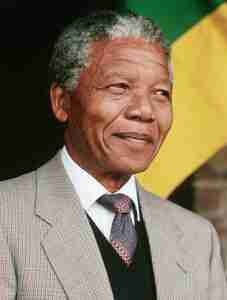By CHARMAINE NORONHA
Nelson Mandela
PHOTO COURTESY OF BIOGRAPHY.COM
QUNU, South Africa – July 18 marks 100 years since the birth of Nelson Mandela, who died in 2013.
Visitors can follow in Mandela’s footsteps from the villages where he was born and raised, to the Soweto township where he became an anti-apartheid leader, to Robben Island where he was imprisoned for years.
THE EASTERN CAPE
“When Mandela was just a child, he walked for miles on this route, moving from one village to another,” said tour guide Velile Ndlumbini as we drove through the picturesque green rolling hills of the Eastern Cape.
The homestead where he was born can be seen in the small village of Mvezo. He lived here until age 2, when his father lost his position as village chief in a dispute with a magistrate. The family then moved to neighboring Qunu, where Mandela lived until age 9, when his father died. He and his mother then moved 19 kilometers (12 miles) away to Mqhekezweni.
Here he was adopted by the acting regent king and groomed for leadership. Mandela wrote in his autobiography, “Long Walk to Freedom,” that his interest in politics was first kindled listening to tribal elders holding community meetings in Mqhekezweni. A shady spot under a circle of gum trees, Ndlumbini said, is still used for that purpose. It was Qunu where Mandela returned after 27 years in prison. He built a complex there along the N2 highway for his family, where some still live, and he moved back to Qunu himself after retiring from public life.
Dusty roads lead to his private grave, across from his family’s burial site.
Qunu also houses the Nelson Mandela Museum, which opened on Feb. 11, 2000, the 10th anniversary of his release from prison. It takes visitors from his childhood through his involvement in politics to his triumphant election as president.
Some 200 kilometers (125 miles) south lies the Steve Biko Museum in King William’s Town. Biko was an icon of anti-apartheid activism, an African nationalist and a leader of the grassroots Black Consciousness Movement. He was a major influence on Mandela, and died in 1977 after being arrested and beaten. In neighboring Mandela Bay in Port Elizabeth, an installation called Route 67 showcases 67 artworks symbolizing Mandela’s 67 years of service. The art, all by locals, depicts significant moments on the journey from apartheid to democracy, moving from laser-cut steel figures forming a voting line in the country’s first democratic elections in 1994, to a stairway that starts in darkness and progresses to an era of color and new beginnings.
SOWETO
Created in the 1930s by the white government to relocate the black population away from Johannesburg, Soweto became the largest black city in South Africa. Poverty was rampant in the shanty towns and civil unrest was common during apartheid.
Mandela lived in Soweto from 1946 to 1962 and met African National Congress activist Walter Sisulu there.
Mandela’s Soweto home has also been converted into a museum. But the most exhaustive and heartbreaking site is the Apartheid Museum. The entrance is divided into “blankes/whites” and “nie-blankes/non-whites,” followed by a display of “passes” that the black population was required to carry, restricting their movements. The museum details the white settlers’ history in South Africa, the beginnings of apartheid and daily struggles blacks endured, along with the story of how Mandela transformed the African National Congress into a mass political movement.









No Comment